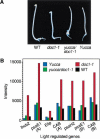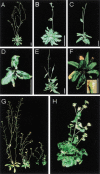BIG: a calossin-like protein required for polar auxin transport in Arabidopsis
- PMID: 11485992
- PMCID: PMC312751
- DOI: 10.1101/gad.905201
BIG: a calossin-like protein required for polar auxin transport in Arabidopsis
Abstract
Polar auxin transport is crucial for the regulation of auxin action and required for some light-regulated responses during plant development. We have found that two mutants of Arabidopsis-doc1, which displays altered expression of light-regulated genes, and tir3, known for its reduced auxin transport-have similar defects and define mutations in a single gene that we have renamed BIG. BIG is very similar to the Drosophila gene Calossin/Pushover, a member of a gene family also present in Caenorhabditis elegans and human genomes. The protein encoded by BIG is extraordinary in size, 560 kD, and contains several putative Zn-finger domains. Expression-profiling experiments indicate that altered expression of multiple light-regulated genes in doc1 mutants can be suppressed by elevated levels of auxin caused by overexpression of an auxin biosynthetic gene, suggesting that normal auxin distribution is required to maintain low-level expression of these genes in the dark. Double mutants of tir3 with the auxin mutants pin1, pid, and axr1 display severe defects in auxin-dependent growth of the inflorescence. Chemical inhibitors of auxin transport change the intracellular localization of the auxin efflux carrier PIN1 in doc1/tir3 mutants, supporting the idea that BIG is required for normal auxin efflux.
Figures






Similar articles
-
CRM1/BIG-mediated auxin action regulates Arabidopsis inflorescence development.Plant Cell Physiol. 2007 Sep;48(9):1275-90. doi: 10.1093/pcp/pcm094. Epub 2007 Jul 24. Plant Cell Physiol. 2007. PMID: 17652113
-
The auxin transport inhibitor response 3 (tir3) allele of BIG and auxin transport inhibitors affect the gibberellin status of Arabidopsis.Plant J. 2005 Jan;41(2):231-42. doi: 10.1111/j.1365-313X.2004.02287.x. Plant J. 2005. PMID: 15634200
-
Reduced naphthylphthalamic acid binding in the tir3 mutant of Arabidopsis is associated with a reduction in polar auxin transport and diverse morphological defects.Plant Cell. 1997 May;9(5):745-57. doi: 10.1105/tpc.9.5.745. Plant Cell. 1997. PMID: 9165751 Free PMC article.
-
Auxin transport: why plants like to think BIG.Curr Biol. 2001 Oct 16;11(20):R831-3. doi: 10.1016/s0960-9822(01)00497-3. Curr Biol. 2001. PMID: 11676938 Review.
-
Transmembrane auxin carrier systems--dynamic regulators of polar auxin transport.Plant Growth Regul. 2000 Nov;32(2-3):161-72. doi: 10.1023/a:1010701527848. Plant Growth Regul. 2000. PMID: 11758564 Review.
Cited by
-
Shade avoidance.Arabidopsis Book. 2012;10:e0157. doi: 10.1199/tab.0157. Epub 2012 Jan 19. Arabidopsis Book. 2012. PMID: 22582029 Free PMC article.
-
Phototropism: mechanism and outcomes.Arabidopsis Book. 2010;8:e0125. doi: 10.1199/tab.0125. Epub 2010 Aug 31. Arabidopsis Book. 2010. PMID: 22303252 Free PMC article.
-
UBR4/POE facilitates secretory trafficking to maintain circadian clock synchrony.Nat Commun. 2022 Mar 24;13(1):1594. doi: 10.1038/s41467-022-29244-1. Nat Commun. 2022. PMID: 35332162 Free PMC article.
-
Studies on the function of TM20, a transmembrane protein present in cereal embryos.Planta. 2005 Sep;222(1):80-90. doi: 10.1007/s00425-005-1519-3. Epub 2005 Apr 19. Planta. 2005. PMID: 15838668
-
SIZ1 regulation of phosphate starvation-induced root architecture remodeling involves the control of auxin accumulation.Plant Physiol. 2011 Feb;155(2):1000-12. doi: 10.1104/pp.110.165191. Epub 2010 Dec 14. Plant Physiol. 2011. PMID: 21156857 Free PMC article.
References
-
- Anderson JT, Rogers RP, Jarrett HW. Ca2+-calmodulin binds to the carboxyl-terminal domain of dystrophin. J Biol Chem. 1996;271:6605–6610. - PubMed
-
- Ausubel FM, Brent R, Kingston RE, Moore DD, Seidman JG, Smith JA, Struhl K. Current protocols in molecular biology. New York: John Wiley & Sons; 1994.
-
- Bartel B, Fink GR. ILR1: An amidohydrolase that releases active indole-3-acetic acid from conjugates. Science. 1995;268:1745–1748. - PubMed
Publication types
MeSH terms
Substances
Grants and funding
LinkOut - more resources
Full Text Sources
Other Literature Sources
Molecular Biology Databases
Miscellaneous
